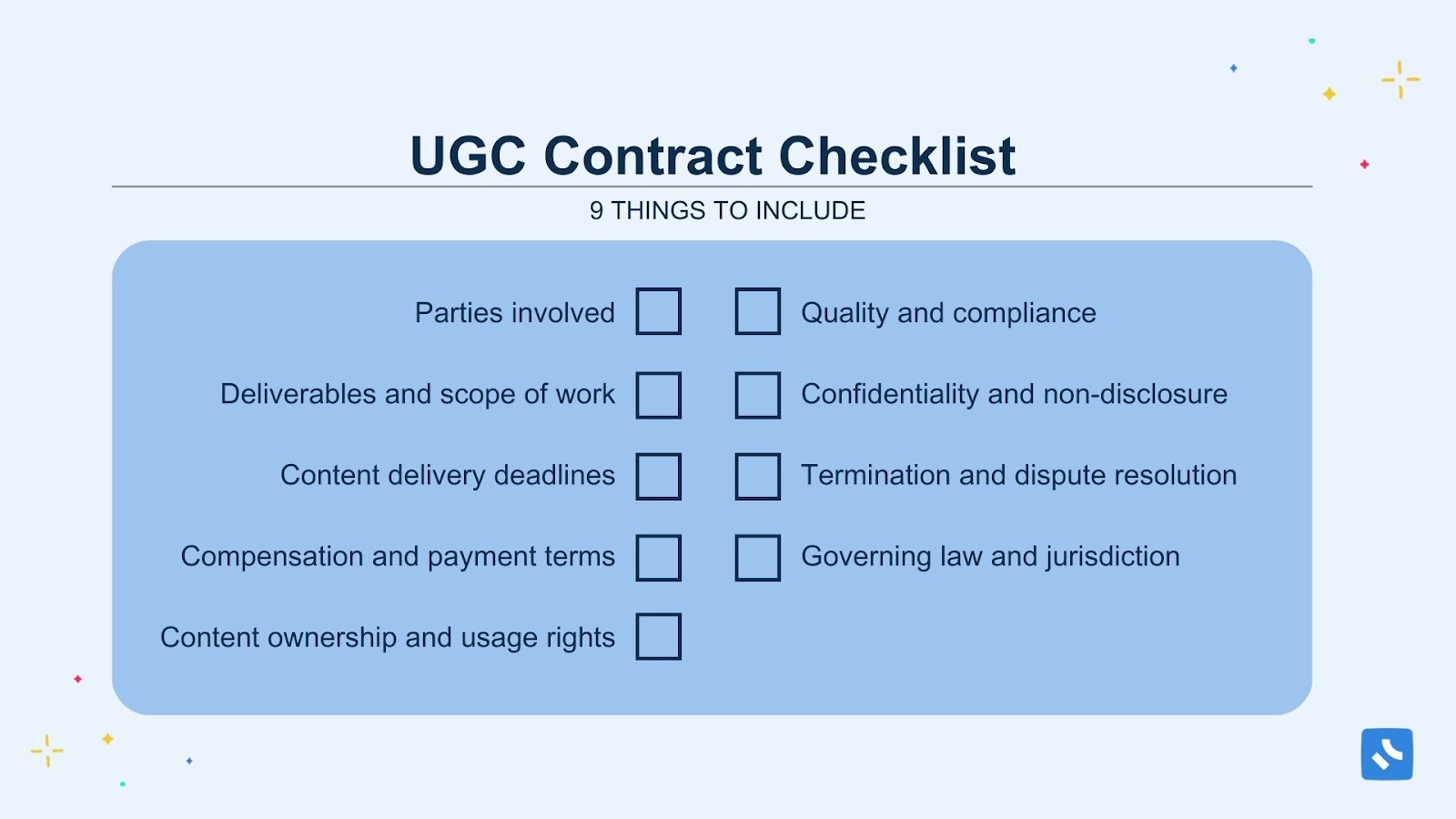Free UGC contract template (10 pages)
Approximately 70% of brands believe that user-generated content (UGC) helps them better engage with customers on social media. And that’s true, as UGC leads to 29% higher conversion rates compared to non-UGC campaigns.
Yet, among the benefits of authentic UGC lies a critical consideration — the need for legal compliance and protection of intellectual property rights.
In this article, we share everything you need to know about UGC contact, including a free UGC contract template:
- Reasons why you should use a UGC contract
- 9 Things you must include in your UGC contract
- 3 Strategies for crafting an effective UGC contract
What is a UGC Contract?
A UGC contract, also known as a UGC creator contract, is a legal agreement that formalizes the partnership between a brand and a UGC creator.
It serves as a foundational document that outlines the terms, conditions, and expectations governing their collaboration.
At its core, a UGC contract describes various critical aspects of the collaboration, including:
- Scope of Work: It lays out exactly what the content creator will do, including the type of content, where it will be posted, and any rules they need to follow.
- Content Deliverables: It’s clear what the UGC creator needs to make and how good it should be. This includes things like the style and how it should sound.
- Compensation: UGC contracts contain info about how much and when the creator will get paid, depending on what they’re doing and how experienced they are.
- Usage Rights: This is about who can use the content and how. It covers things like if the brand can change it and where they can put it.
- Ownership Rights: The contract clarifies who owns the content once it’s made. Both sides know who’s responsible for it.
- Deadlines: The contract sets dates for when things need to be done. This makes sure the project stays on track.
- Other Specific Requirements: Any other important stuff that’s specific to this collaboration goes in here.
Read more: 6 Best Ways To Find UGC Creators in 2024
Importance of using a UGC contract
Imagine this: You’re a small business owner wanting to use UGC to boost your brand online. You find a photographer whose style matches your brand on social media. You ask them to work together, but the deadlines are missed, the work isn’t good enough, and they won’t let you use it where you need it.
This is where a UGC contract makes all the difference.
Here are the major benefits a UGC contract brings to your table:
- Clearly defined expectations: By outlining the scope of work, content requirements, deadlines, and deliverables, you will avoid misunderstandings and know both parties are on the same page.
- More accountability: By signing a UGC contract both parties are committed to the collaboration’s success. This formal commitment leads to a higher sense of accountability.
- Legal protection: The contract outlines the rights and responsibilities of each party and helps prevent any potential legal disputes or infringement issues. It establishes a clear framework for how the content can be used and protects the intellectual property rights of the content creator.
- Intellectual property rights: UGC contract can outline whether the rights to the content remain with the creator or if they are transferred to the brand or platform. This prevents unauthorized use or distribution of the content in the future.
- Termination and dispute resolution: A UGC contract provides clarity in case the collaboration needs to be ended prematurely or if any disagreements arise. Clear guidelines on notice periods, obligations, and resolution options can help resolve conflicts and protect the interests of both parties.
9 Things Every UGC Contract Must Contain
In crafting a comprehensive UGC contract, it’s essential to include key clauses that ensure clarity, protection, and mutual understanding between all parties involved.

Here’s an overview of the essential elements:
1. Parties involved
Identify and provide full contact information for all parties involved in the UGC contract. That means including the UGC creator and the brand.
2. Deliverables and scope of work
This can include the type of content to be created (e.g., photos, videos, text), the quantity or duration of content required, and any specific requirements or guidelines for the content.
Example: The creator will provide the brand with 10 user-generated photos featuring the brand’s products, showcasing them in various lifestyle settings.
3. Content delivery deadlines
Establish the timeline for content creation, submission, and review. Define deadlines for deliverables and milestones. If applicable. Include any provisions for extensions or penalties for missed deadlines.
Example: The creator should deliver the 10 photos to the brand’s marketing team for review within 14 days of the agreement’s signing date.
4. Compensation and payment terms
Detail the financial aspects of the agreement. Specify the compensation rate, payment method, and any additional compensation, royalties, or incentives. Outline the payment schedule, due dates, and any penalties for late or non-payment.
Example: The brand will compensate the creator $100 per photo upon satisfactory acceptance, with payment to be made within 30 days of receipt of the invoice.
In the event of late payment, a penalty of 5% of the total invoice amount shall be applied for each week the payment is overdue, up to a maximum of 20%.
5. Content ownership and usage rights
Be clear about how the content can be used by the brand. Include the right to publish, display, distribute, modify, or sublicense the content.
Address any restrictions, such as geographic limitations or exclusivity periods. Specify whether the content creator retains ownership or if it is transferred to the brand.
6. Quality and Compliance
This includes guidelines for accuracy, adherence to brand guidelines, legal compliance, and any necessary disclaimers or disclosures.
Example: The creator agrees to produce high-resolution photos free from watermarks or any third-party intellectual property violations.
7. Confidentiality and non-disclosure
Include a section that protects the confidentiality of any sensitive or proprietary information shared during the collaboration. Specify obligations related to confidentiality and any limitations on the use or disclosure of such information.
Example: Both parties agree to maintain confidentiality regarding any proprietary information exchanged during the project, including but not limited to brand strategies and future product launches.
8. Termination and dispute resolution
Outline conditions for contract termination by either party and procedures for resolving disputes. This could include a clause specifying a notice period for termination and steps for mediation or arbitration if disagreements arise.
9. Governing law and jurisdiction
Specify the applicable jurisdiction and governing law that will apply to understanding and enforcing the contract.
Example: This contract shall be governed by the laws of [insert state or country], and any disputes shall be resolved in the courts of [insert jurisdiction].
Read more: Top 50 UGC Platforms to Try Out in 2024
3 Best Practices for Creating an Effective UGC Contract
When writing a UGC contract, there are three proven strategies you can use to make sure the contract is effective and comprehensive:
1. Engage a lawyer to review the contract
Consult with a qualified lawyer to review the contract thoroughly. This way you can be sure about its compliance with relevant laws and protect the rights and interests of all parties involved.
2. Address content ownership
This is one of the most important things you need to include in your UGC contract. Being clear about content ownership will help you handle your UGC collaborations like a pro. So, clearly state whether the rights remain with the creator or if they are transferred to the brand or the platform that is commissioning the content.
3. Define payment terms
Outline the payment methods, rates, timing, and any additional compensation or royalties, if applicable. This clarity helps establish a fair and transparent payment structure for both parties involved.
Conclusion
Now that you know the essentials of a UGC contract and have a UGC contract template you can adapt and use, nothing stops you from creating the best UGC campaign for your brand.
Follow the strategies mentioned above to avoid the biggest mistakes brands make when partnering with UGC creators.
Lastly, if you want to partner with UGC creators to get high-quality content for your brand, let’s talk. We can fully manage your entire UGC strategy, from finding the right creators to delivering the final UGC posts (after providing feedback and guiding all creators).
Want to partner with UGC creators?
We can find and connect you with any UGC creator in the world and hire them to create the best UGC for your brand.



